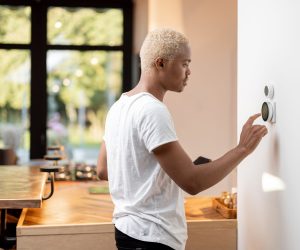Why is my AC giving off bad smell?
Musty smell is a common problem when it comes to air conditioners.
It’s an unpleasant odor that can be caused by a variety of factors, including HVAC duct problems, clogged filters, clogged drain lines, and mildew or mold buildup.
In order to get rid of the musty smell, it’s important to determine the source of the odor, and then take the appropriate steps to get rid of it.
How to get rid of bad smell from air conditioner
The best way to get rid of bad smell from an air conditioner is to regularly clean the filters and coils.
Additionally, changing the air filter every 1–2 months can help reduce odors, while using an air purifier can eliminate any lingering smells.
How do you get a musty smell out of an air conditioner?
One of the most common causes of a musty smell in an air conditioner is clogged filters.
If the filter is not changed or cleaned regularly, dust, dirt, and other debris can accumulate, leading to a musty smell.
Clogged drain lines can also be a source of musty smells, as the water accumulation can lead to mold and mildew growth.
What to do?
Once you’ve identified the source of the musty smell, you can take steps to get rid of it.
1. Carefully remove the outer case of the air conditioner and move it to a secure place.
2. Then, blow compressed air through the coil and the ducts, and use a brush or cloth to clean any finer dust particles.
3. Clean the vents and the ducts, and flush the drip tray with a cleaning solution.
4. Allow the air conditioner to dry completely, and then reassemble it.
If the musty smell persists, or if you find evidence of mildew or mold, it may be time to call a professional.
A professional can inspect the location and extent of the mildew, as well as any moisture or filth that may have collected in the coil and ductwork.
 Types of Air Conditioner Smells, Possible Causes and What You Can Do
Types of Air Conditioner Smells, Possible Causes and What You Can Do
In addition to musty smells, there are a few other types of air conditioner smells and their possible causes.
1.Exhaust
If your air conditioner smells like car exhaust, it may be due to a leak in the refrigerant line.
2.Burning
If it smells like something is on fire, there may be an issue with the electrical components.
3. Rotten Eggs
If it smells like rotten eggs, it may be due to a chemical leak, such as Methyl Mercaptan.
4. Skunk
If it smells like gas or skunk, it could be due to a natural gas leak.
5. Cigarettes
Cigarette smoke smell can also be a problem, as the evaporator coil and filter can absorb the odor. In this case, the filter should be changed and the AC should be cleaned regularly.
DIY Repairs
Before doing any DIY repairs on an air conditioner, it is important to take certain precautions.
Never attempt to do air conditioner repairs by yourself; instead, go over the maintenance and operating manuals.
Collect the right set of tools, and make sure to turn off the main power supply.
Have the right personal protective equipment, such as rubber gloves and a face mask, and never try to mask any bad smells.
 In conclusion,
In conclusion,
To get rid of bad smell from an air conditioner, check and clean the air filter, coils, and drain pan regularly.
You can also use an air purifier to eliminate any odors and a bleach solution to remove bacteria and mold that may be causing the smell.
Additionally, checking the drain line for any blockages can help reduce the smell.
Cleaning the air conditioner with a bleach solution can also help remove any bacteria and mold that may be causing the smell.
Musty smells are a common issue with air conditioners, and can be caused by clogged filters, clogged drain lines, and mold growth.
To get rid of the musty smell, carefully remove the outer case of the air conditioner, blow compressed air, and clean the vents and ducts.
If the musty smell persists, or if you find evidence of mildew or mold, it may be time to call a professional.
Other types of air conditioner smells, such as car exhaust, fire, rotten eggs, gas, and skunk, can also be caused by different issues.
Before doing any DIY repairs, make sure to take the necessary precautions.
Faq
1. What is a musty smell?
A musty smell is an unpleasant odor that is often caused by mold or mildew buildup.
It is most commonly found in air conditioners, but can also be found in other areas of the home or office.
Musty smells are caused by the buildup of moisture, which can trigger the growth of mold and mildew.
2. What are the causes of musty smell in air conditioners?
The most common causes of musty smell in air conditioners are clogged filters, clogged drain lines, and mildew or mold buildup.
Clogged filters can cause dust, dirt, and other debris to accumulate and create a musty smell.
Clogged drain lines can also cause water accumulation, which can lead to mold and mildew growth.
3. How can I get the musty smell out of my air conditioner?
To get rid of the musty smell in your air conditioner, it is important to first identify the source of the odor.
Once you have identified the source, you can take the following steps: carefully remove the outer case of the air conditioner and move it to a secure place;
blow compressed air through the coil and the ducts; use a brush or cloth to clean any finer dust particles; clean the vents and the ducts; and flush the drip tray with a cleaning solution.
Allow the air conditioner to dry completely, and then reassemble it.
4. When should I call a professional for help?
If the musty smell persists, or if you find evidence of mildew or mold, it may be time to call a professional.
A professional can inspect the location and extent of the mildew, as well as any moisture or filth that may have collected in the coil and ductwork.
It is also recommended to call a professional if you are unfamiliar with DIY air conditioner repairs or if you are unable to find the source of the musty smell.
5. What are the other types of air conditioner smells and their possible causes?
In addition to musty smells, there are a few other types of air conditioner smells and their possible causes.
If your air conditioner smells like car exhaust, it may be due to a leak in the refrigerant line.
If it smells like something is on fire, there may be an issue with the electrical components.
If it smells like rotten eggs, it may be due to a chemical leak, such as Methyl Mercaptan.
If it smells like gas or skunk, it could be due to a natural gas leak.
6. What precautions should I take before doing any DIY repairs on my air conditioner?
Before doing any DIY repairs on an air conditioner, it is important to take certain precautions.
Never attempt to do air conditioner repairs by yourself; instead, go over the maintenance and operating manuals.
Collect the right set of tools, and make sure to turn off the main power supply.
Have the right personal protective equipment, such as rubber gloves and a face mask, and never try to mask any bad smells.
7. What causes moldy or musty smells in air conditioners?
Moldy or musty smells in air conditioners are usually caused by an accumulation of water in the drain pan or drip lines, or by dirty air filters.
If the filters are not changed or cleaned regularly, dust, dirt, and other debris can accumulate, leading to a musty smell.
Clogged drain lines can also be a source of musty smells, as the water accumulation can lead to mold and mildew growth.
8. What is the best way to get rid of cigarette smoke smell in an air conditioner?
The best way to get rid of cigarette smoke smell in an air conditioner is to change the filter and clean the AC regularly.
The evaporator coil and filter can absorb the odor, so it is important to make sure they are clean.
It is also important to ensure that no one smokes near the air conditioner, as the smoke particles can easily get trapped in the filter.
9. What should I do if I find a dead animal in my air conditioner?
If you find a dead animal in your air conditioner, it is important to take the appropriate steps to remove it.
First, make sure to turn off the power to the unit. Then, carefully remove the outer case of the air conditioner and move it to a secure place.
You can then use a brush or cloth to clean the finer dust particles and remove the carcass.
Finally, allow the air conditioner to dry completely before reassembling it.
10. What are the hazards of DIY air conditioner repairs?
DIY air conditioner repairs can be dangerous, as they involve working with electrical components and power wires.
If done improperly, DIY repairs can lead to electric shock or even fire. In addition, DIY repairs can also cause allergic reactions, headaches, and other health issues.
It is therefore important to take the necessary precautions before attempting any DIY air conditioner repairs.


















 What’s the Best Air Purifier for Sinuses?
What’s the Best Air Purifier for Sinuses?

 Best Locations for Air Purifiers to Relieve Sinus Issues
Best Locations for Air Purifiers to Relieve Sinus Issues







